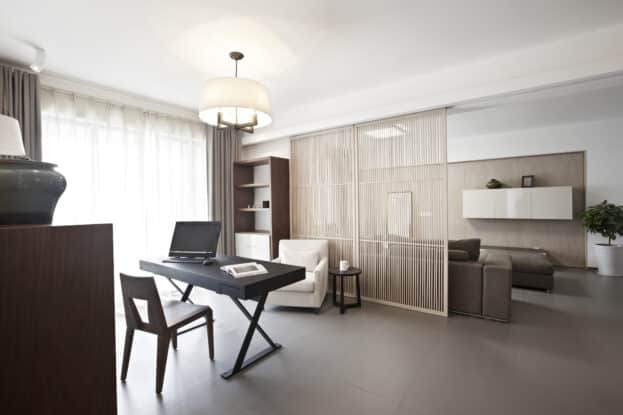As the world grapples with the deadly coronavirus, millions of people in Israel and across the globe have found themselves establishing makeshift offices to work remotely from home. In many sectors, this unprecedented phenomenon has been so well received that employers are considering adopting it as a more permanent measure to minimize office rent and expenses, provide staff with more flexible working options and save employees’ valuable travel time.
Establishing a functional workspace in your home is key to making this long-awaited transformation succeed. To help you do that, now and in the long-term, here are our top ten tips for a practical and beautiful (why not?) home office in Israel:
1. Location, location, location
Find a space in your home that is available and that can accommodate your needs for working from home. Do you work light or with a fully loaded workstation? Start by defining the parameters of your workspace: Technology, industry-specific equipment, storage – file/books/samples, perhaps (one day soon) a space for meeting with clients or colleagues. Be mindful of your ergonomic needs – a table at a comfortable height and a good chair with adjustable height, you may even consider a console at standing height to ease up on lower back issues. Don’t forget your Internet requirements: Consider the proximity of your Wi-Fi router to your workspace or deploy a Wi-Fi extender if necessary.
2. Noisy neighbors
Slamming doors, TV-noise, “heated discussions” – all-acoustic hazards in your new working environment. If you can’t drown them out with earplugs or white noise, then consider some sound absorption materials such as fibrous ceiling/ floor coverings and ceiling mounted acoustic panels which also allow inset lighting solutions. You can also reduce noise and add an interesting design element with decorative wood and ceramic coverings, textile wall hangings, area rugs, cork tile flooring, not to mention green walls with built-in irrigation systems.
3. Define your work style
The nature of your job determines how much you talk on the phone, or need to concentrate without distractions, but to optimize your environment you’ll have to be honest with yourself about your work style. Are you minimalist, disorganized, erratic, easily distracted, a bit obsessive? Smart design should encourage your most efficient, composed, and ordered self. The types of things to consider here are open shelving, drawer space, even use of color and pattern.
4. Carve out your space
When space is at a premium, bespoke furniture can maximize what you have, hide away your office in a cupboard or accommodate multiple functions. Carpentry can incorporate and even enhance existing room features such as windows, alcoves, niches, and electrical sockets. Not to mention adding a unique flavor and style.
5. Get into the zone
For those that don’t have the luxury of a separate workspace or studio, you can still signal to yourself and your family that you are “at work”. Create a physical boundary between your living and workspaces and establish a sense of separation without making a room feel small. Positioning furniture such as bookcases, consoles, or sideboards on the back of a sofa. Two-sided fireplaces, glass partitions, or free-standing dividers such as open shelving, bespoke carpentry with open shelving, curtains, and portable screens. If you’re feeling adventurous you can suspend shelving, artwork, or screens from the ceiling. We can also section a room using color (a darker shade of the main room color), artwork, and area rugs can all delineate separate zones within an open space.
6. Keep it light
Numerous studies show that natural light can improve productivity, well-being and reduce headaches and eyestrain, but if your desk is near a window then consider the right window treatment. Shutters and curtains can block out the sun, while shades and blinds can add a softer more elegant tone, provide privacy and limit the sun’s glare. Regarding artificial light, I usually divide lighting in an office into general lighting from ceiling fixtures, task lighting from a wall light by the work area or desk lamp and mood lighting which adds style and softens harsher light with pendants, standing lamp or wall lights.
7. A room with a view
If you can’t look at nature then bring some of the outside in. Research shows that plants improve productivity and serotonin levels. I always introduce plants into my designs, and for those clients that insist they will inevitably kill any plant, I suggest cacti and succulents which don’t need much water.
8. Keep track of time
There’s a reason casinos, restaurants, and shops don’t have wall clocks. Whether you need to stay on-task, break up the workday or regulate workaholic tendencies, having a clock helps structure your working day. Clocks can also provide an interesting decorative element: a large wall clock or grandfather clock statement piece, a more complementary accent piece, or a collection of wall clocks hung as a composition.
9. Make it personal
Your home office design reflects an extension of yourself and should complement your home, particularly when open plan living. I always ask clients, no matter what the scale of their project, what do you want to feel in this space? To be fair fully developing the concept of design that suits your personal and professional narrative is not something we can tackle in this short article format. But you can kick-off in the right direction by considering what matters to you, personally, in a working space – whether it’s a sense of harmony, creativity, insight, focus, motivation, empowerment etc. Consider what materials, colors and patterns complement those feelings and resonate for you. Additionally, while we are trying to establish a separate space from home life, you’re still going to spend many hours here, so keep it personal by adding art, shelving for books that inspire you, favorite ornaments and souvenirs.
10. Create a new workspace
Lastly, if your current home structure can’t accommodate a private working space, and you have the budget, then consider building a garden office, a home extension, closing a balcony space, or converting a garage/basement/attic/storage room. Not only does this ensure you tailor the room to your needs, but it may also add significant value to your home. You’ll need working plans, planning permission, and patience, but the Coronavirus has afforded us plenty of time for all of that!
“When space is at a premium, bespoke furniture can maximize what you have, hide away your office in a cupboard, or accommodate multiple functions.”

Influenced by modern European design, British-born interior designer Rebecca Citrin today lives and works in Israel. She was recently nominated for House Design of 2019-2020 by leading Israeli design magazine Binyan V’Diur. Rebecca can be reached at 054-5203033 or [email protected]



